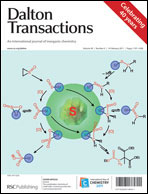Nanoparticulate Cd1−xZnxO (x = 0, 0.05–0.26, 1) is synthesized in a simple two-step synthesis approach. Vapor-diffusion induced catalytic hydrolysis of two molecular precursors at low temperature induces co-nucleation and polycondensation to produce bimetallic layered hydroxide salts (M = Cd, Zn) as precursor materials which are subsequently converted to Cd1−xZnxO at 400 °C. Unlike ternary materials prepared by standard co-precipitation procedures, all products presented here containing < 30 mol% Zn2+ ions are homogeneous in elemental composition on the micrometre scale. This measured compositional homogeneity within the samples, as determined by energy dispersive spectroscopy and inductively coupled plasma spectroscopy, is a testimony to the kinetic control achieved by employing slow hydrolysis conditions. In agreement with this observation, the optical properties of the materials obey Vegard's Law for a homogeneous solid solution of Cd1−xZnxO, where x corresponds to the values determined by inductively coupled plasma analysis, even though powder X-ray diffraction shows phase separation into a cubic mixed metal oxide phase and a hexagonal ZnO phase at all doping levels.
![Graphical abstract: Cd1−xZnxO [0.05 ≤ x ≤ 0.26] synthesized by vapor-diffusion induced hydrolysis and co-nucleation from aqueous metal salt solutions](/en/Image/Get?imageInfo.ImageType=GA&imageInfo.ImageIdentifier.ManuscriptID=C0DT01558J&imageInfo.ImageIdentifier.Year=2011)
You have access to this article
 Please wait while we load your content...
Something went wrong. Try again?
Please wait while we load your content...
Something went wrong. Try again?
![Graphical abstract: Cd1−xZnxO [0.05 ≤ x ≤ 0.26] synthesized by vapor-diffusion induced hydrolysis and co-nucleation from aqueous metal salt solutions](/en/Image/Get?imageInfo.ImageType=GA&imageInfo.ImageIdentifier.ManuscriptID=C0DT01558J&imageInfo.ImageIdentifier.Year=2011)

 Please wait while we load your content...
Please wait while we load your content...